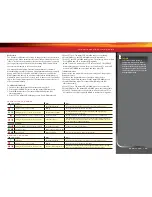
SLASH 4x4 • 21
3 on the rear suspension arms). If you plan on driving on hard
surfaces the following changes should be made:
1. Move the front shocks to position 3 on the suspension arms.
2. Move the rear shocks to position 4 or 5 on the suspension arms.
3. Add a 4mm preload spacer to the front shock.
4. Position 1 is not recommended for front or rear.
Fine Tuning the Shocks
The four shocks on the model greatly influence its handling.
Whenever you rebuild your shocks, or make any changes to
the pistons, springs or oil, always make
changes to them in pairs (front or rear).
Piston selection depends on the range of
oil viscosities that you have available. For
example, using a two-hole piston with a
lightweight oil will, at one point, give you
the same damping as a three-hole piston
with heavier oil.
We recommend using the two-hole pistons
with a range of oil viscosities from 10W
to 50W (available from your hobby shop).
The thinner viscosity oils (30W or less) flow
more smoothly and are more consistent,
while thicker oils provide more damping.
Use only 100% pure silicone shock oil to
prolong seal life. From the factory, shock oil
is set to 50W in the front shocks and 40W in
the rear shocks.
The model’s ride height can be adjusted by adding or removing the
clip-on, spring pre-load spacers. Adjust the ride height so that the
suspension arms are slightly above being parallel to the ground.
Observe how the model handles in turns. Proper set-up will add
stability and help prevent spin outs. Experiment with different
springs and shock oils to find what works best for your current track
conditions.
Centering Your Servo
If you have removed the servo horn from your model’s steering servo,
or the servo has been removed for service or cleaning, the servo must
be re-centered prior to installation of the servo horn or installation of
the servo in the model.
1. Remove the servo horn from the steering servo.
2. Connect the steering servo to channel 1 on the receiver. Connect
the electronic speed control (ESC) to channel 2. The white wire on
the servo lead is positioned towards the receiver’s LED.
3. Turn the transmitter power switch on. Make certain the
transmitter’s batteries are no depleted.
4. Turn the transmitter’s steering trim knob to the center “0” position.
5. Disconnect motor wires “A” and “C” (see page 10) to prevent the
motor from turning during the next steps. Connect a fresh battery
pack to the speed control and turn on the ESC (see page 16). The
servo’s output shaft will automatically jump to its center position.
6. Install the servo horn onto the servo output shaft. The servo horn
should face toward the center of the chassis and be perpendicular
to the servo body.
7. Check servo operation by turning the steering wheel back and
forth to ensure that the mechanism has been centered properly
and you have equal throw in both directions. Use the transmitter’s
steering trim knob to fine-tune the position of the servo horn so
the model tracks straight when the steering wheel is at neutral.
Adjusting the Slipper Clutch
The model is equipped with an
adjustable slipper clutch which is built
into the large spur gear. The purpose
of the slipper clutch is to regulate the
amount of power sent to the wheels
to prevent tire spin. When it slips, the
slipper clutch makes a high-pitch,
whining noise. To adjust the slipper,
use the included wrench to hold
the adjusting nut and roll the model
forward to tighten and reverse to loosen.
Place the model on a high-traction surface, such as carpet . Adjust the
slipper so that you can hear it slip for approximately two feet from a
standing, full throttle start. (Learn more about adjusting the slipper
clutch in the sidebar.)
BASIC TUNING ADJUSTMENTS
To achieve a good starting
point for the slipper clutch
in this model, remove the
slipper gear assembly from
your model (
see page 23 for
instructions
) and tighten the
slipper clutch adjusting nut
clockwise until the slipper
clutch adjusting spring
fully collapses (do not over
tighten), and then turn the
slipper clutch nut counter-
clockwise one full turn.
Do not run your model with
the slipper clutch adjusting
spring fully compressed. The
minimum recommended
slipper clutch setting is 1/2
turn counter-clockwise from
fully compressed.
If you have questions or need technical assistance, call Traxxas at
1-888-TRAXXAS
(1-888-872-9927) (U.S. residents only)
Pre-load
Spacer












































